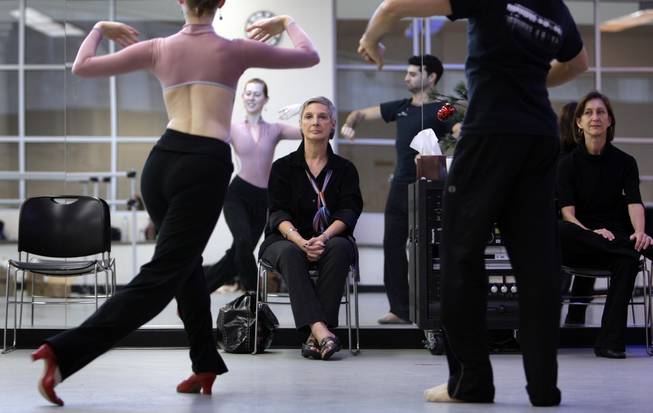
After a distinguished dance career, Cynthia Gregory is advising the Nevada Ballet Theatre.
Tuesday, Dec. 28, 2010 | 2 a.m.
Beyond the Sun
Cynthia Gregory has been called many things during her dancing career: the Swan Queen, a luminary, a controversial artist and, as Rudolf Nureyev once referred to her, America’s prima ballerina.
But she’d best be described this particular afternoon as benevolently critical as she rattles off advice for Nevada Ballet Theatre dancers in rehearsal: “Think up, rather than out in that jeté. You lose your head in that arabesque. I’d like to see the little steps littler and the big steps bigger. Don’t put too much weight on either foot. Lighter. Completely lighter.”
Dancers stop to catch their breath, then work the steps over and over. That’s why Gregory is here. For the little things, the tweaks, the perfection.
“I was very lucky to work with the greatest choreographers of the 20th century,” she says after rehearsal. “Agnes de Mille. Balanchine. And I had wonderful coaches. So I like to pass on what they gave me and I need to do that. I feel compelled to do that, to give the dancers what I learned from all of these great people.”
Dancing professionally since age 15, Gregory spent 26 years with American Ballet Theatre, including the high profile and sometimes-stormy era of Mikhail Baryshnikov. Since retiring from the company in 1991, she has staged, coached and served as a guest artist with companies throughout the U.S.
Now in her 60s, she settled in Las Vegas about a year ago, then joined the Nevada Ballet team and has been establishing Nevada Ballet’s Cynthia Gregory Center for Coaching, which she hopes will draw dancers working with other companies, particularly those in the Southwest.
Getting Gregory onboard as an artistic adviser has been a masterstroke and another step forward for the 37-year-old Las Vegas company, which has revamped over the past two years and is progressing artistically and organizationally toward its upcoming Smith Center for the Performing Arts residency.
Artistic Director James Canfield says he’s thrilled about Gregory’s involvement and the opportunity for her to share her experience and artistic and technical depth with the company.
“Ballet is an art form that is passed down from generation to generation, and even in this technological world we live in, no video or film will ever replace the personal experience and inspiration that Cynthia brings to the studio,” he says. “She is an American treasure.”
Gregory considers Canfield — a classically trained yet cutting-edge artist — an important part of the evolution of dance: “edgy, but based in classical.”
Gregory, too, has balanced the realms of traditional and contemporary, but notices that today’s dancers are missing the connection so essential for dancers in her era.
Dancers today, she says, are more athletic, a little less engaged with each other and the audience.
“I’m trying to give it some heart and soul. That’s what I learned from Agnes de Mille, who said ‘you have to be a person.’ One of my strengths is in taking the story and feeling the music.”
Another strength is in helping retiring dancers face the “what next” of their lives.
Gregory served as chairwoman for the nonprofit organization Career Transitions for Dancers, which helps dancers. (They have moved into second careers such as law, social work, botany, landscape design.)
Dancers have little time or inclination to ponder retirement until the day is upon them.
“Dancers have a different mind-set,” Gregory says. “They’re hard workers, devoted. When dancing, you just don’t think you’re suited for anything else. Most dancers haven’t been to college.
“When I retired, someone told me, ‘You have been on a freeway going straight for a long time. Now you’re going to get off on the side roads, meander a little, make a few stops.’ That was hard for me. You think of yourself as this driven person, doing this art.
“Once you’re a dancer, you’re always a dancer. You keep that spirit in you. I’m pretty proud to have been a dancer.”
In her own transition, Gregory wrote a couple of books — “Ballet Is the Best Exercise” and the children’s book, “Cynthia Gregory Dances Swan Lake” — and took up drawing.
She says her writing days might be over but might write about the men she’s danced with: “I was always looking for a perfect partner. I never found one because I was so tall, but I always looked for them and I had fun looking.” Among her favorites were Nureyev (“a dream come true”), Fernando Bujones, Erik Bruhn, Peter Martins.
She remembers the exact date of her first full-length classical ballet, April 23, 1967, as Odette Odile in “Swan Lake.”
“I just felt born to do that,” she says. “It just felt so right. I really tried to make her as human as possible, falling in love, showing how she was frightened.”
Las Vegas might seem a curious destination for someone steeped in the classical arts. But for Gregory, a Los Angeles native who lived mostly in New York and Connecticut, returning to the West was always tempting. And she knew Las Vegas after spending childhood weekends here.
Now divorced with a son in college, she says, “I had nothing holding me back. I’m so happy to be around palm trees, big sky and mountains. I’m feeling that a whole new life is opening up for me here. Everything is fresh and sun filled.”


Join the Discussion:
Check this out for a full explanation of our conversion to the LiveFyre commenting system and instructions on how to sign up for an account.
Full comments policy